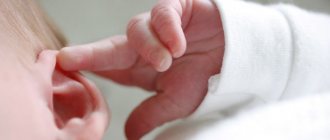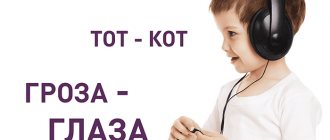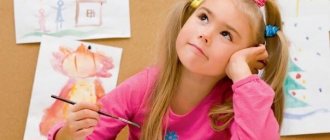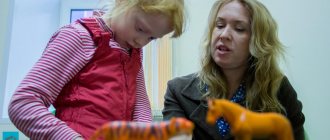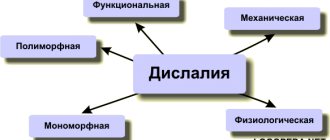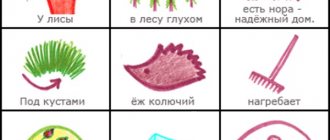The number of children suffering from GSD (general speech underdevelopment) is increasing every year. A similar defect is detected in 70% of babies. It is important to understand that pronunciation defects negatively affect the development of written speech in children of preschool and primary school age. The development of coherent speech in children with special needs development is based on the ability to compose sentences that correspond to their level of development. Linking words in a sentence allows you to express and understand the meaning of what is said. It is the skill of composing lexically and syntactically correct sentences that is the basis of correctional work.
What is ONR
The diagnosis of OHP includes a complex of speech disorders in which the child has not only incorrect articulation, but also problems with comprehending what he hears. To correct the defect, a speech therapist works with preschoolers. Therapy will be more effective the earlier it is started.
A characteristic feature of children diagnosed with general speech underdevelopment is low coherent storytelling skills. The use of speech therapy techniques makes it possible to develop missing skills during the educational and training process in children aged 4–5 years.
Features of speech development of children with mental retardation
Many people study the topic of speech development of children with mental retardation, and the research results are reflected in abstracts and reports. It is known that children with mental retardation have:
- a small supply of information and ideas about the world around us;
- decreased cognitive activity;
- violations of all components of speech;
- decreased formation of mental functions;
- poorly regulated voluntary activity.
Note! A common feature of the coherent speech of children with mental retardation is the difficulty of retelling and telling a story based on a series of plot pictures. Violations of the lexical, grammatical and articulatory structure of speech are also inherent.
How to shape the speech of children with mental retardation
Glukhov’s technique is taken as the basis for the test for differentiating the disorder and determining its degree. The competence of this test is confirmed by numerous studies of students and teachers who include the methodology in the practical part of their diplomas and devote the bulk of the collection of statistical data to it in coursework.
Corrective work on the formation of correct statements in children with mental retardation:
- Formation of clear and clear pronunciation, elimination of defects in sound pronunciation.
- Development of cause-and-effect relationships and the ability to correlate a word and an object (phenomenon, sign or action).
- Increasing vocabulary.
- Eliminating errors in the use of prepositions and case forms.
Note! Enriching children's non-verbal communication is possible through the development of non-verbal means of communication - facial expressions and gestures. Children with mental retardation have poor coordination of facial movements and sluggish articulation, which disrupts the preschooler’s communication with both peers and adults.
Non-verbal means of communication are developed in a playful way - at first all the exercises are shown by the teacher (individually - in front of a mirror or looking “eye to eye", in a group lesson - demonstrating a presentation), followed by joint repetition, and only at the end - an individual demonstration (repetition can be organized exercises in a chain, one after another).
Lesson on speech formation in children
Rules and procedures for speech therapy work
Coherent speech refers to the ability to compose a common sentence or several interconnected phrases to ensure communication and understanding between people. The formation of coherent speech in children with ODD is the basic task of speech therapy correction. It is inextricably linked with the development of thinking. According to E.I. Tikheyeva, without precise thinking it is impossible to learn the skills of combining statements.
It is in the senior preschool period that the child’s thinking changes - his horizons expand, his thinking process improves, new skills appear, and speech is formed.
But the ability to speak is acquired only during communication. Increasing communication skills contributes to the complication of grammatical forms used by a preschooler. If the child has developed the abilities of primitive spoken language, then the passive vocabulary is close to age requirements. He will be able to talk about his friends, relatives or bright events in life.
Correctional classes for preschoolers diagnosed with speech underdevelopment are aimed at:
- improving phonemic skills;
- correction of incorrect articulation (if any);
- increasing the vocabulary, understanding their lexical meaning;
- developing the ability to construct coherent sentences and their intonation decoration;
- development of skills of independent narration and presentation of what is read or heard.
The speech therapist teaches preschoolers where to start a story, how to make it interesting and emotional, and also how to logically and consistently express their thoughts.
It is with the consistency of presentation that difficulties arise in children with general speech disorders. They do not know how to focus on the main idea, break a story into meaningful parts and arrange them correctly. And the speech therapist’s task is to achieve a logical narrative with interconnected parts that is understandable to outside listeners.
Another problem for preschoolers with OHP is the lack of grammatical skills. They make up short non-union phrases, often repeat the same phrases, and their story does not have a logical conclusion. A defectologist specialist explains to children the cause-and-effect relationship, the characteristics of objects and phenomena, their connection to time and place, and teaches them to generalize words according to specific and generic characteristics.
The mastery of coherent storytelling techniques by a preschooler with ODD is an indicator of the effectiveness of speech therapy correction.
To do this, the defectologist uses various techniques:
- clarifications;
- questions;
- display of pictures;
- analysis of existing speech skills.
At each speech therapy session, the specialist combines several techniques to increase the activity of children’s independent expressions. An integrated approach allows you to vary classes depending on the level of speech development and ability to speak independently, the goals set and the activity of the children.
Formation of detailed utterance skills
To teach a child to compose a coherent story, the speech therapist uses reproductive techniques - describing pictures, composing a story based on a series of images. This causes the greatest difficulties for preschoolers with OHP. It is difficult for such children to have reasoning skills, since such statements require logic and reasoning, and substantiation of their opinion. To learn how to write a reasoning story, a preschooler must understand cause-and-effect relationships.
Forming coherent presentation skills in children with speech underdevelopment is a long process. At the initial stage, the child repeats the task, the rules for its implementation, and the resulting conclusion after the teacher. Then the speech therapist artificially creates situations, stimulating the preschooler to make independent statements. At the same time, the teacher regulates the sequence, argumentation and coherence of the narrative by asking leading questions.
To develop coherent storytelling skills in children with SLD, they are taught to draw up a story plan.
Such preschoolers will need more time to master logical storytelling skills. Joint drawing up of a story plan is used not only as a technique for developing coherent speech, but also as an organization of teamwork. Such activities contribute to the formation of the ability to highlight the main idea and build an independent, consistent story. Subsequently, preschoolers master the skills of composing an independent coherent story with a sequential presentation of events.
Psychological and pedagogical characteristics of children with speech disorders
The psychological and pedagogical characteristics of children are based on Levina’s classification, which identifies 3 forms of OHP:
- Level 1, when there is no statement. In everyday life, only onomatopoeia and various sound complexes are used (a small word that a child uses to designate several objects at once).
- Level 2, common speech begins. A preschooler can already pronounce short phrases and participate in dialogues (the answers are usually monosyllabic). Children's monologues contain many errors of both sound and semantic nature.
- Level 3, residual speech underdevelopment. The child actively uses both dialogic and monologue forms. There are still hesitations in the agreement of adjectives and nouns, errors in inflection and word formation of unfamiliar words.
Features of speech of children with mental retardation
Preschoolers with mental retardation (MDD) often use a large number of words without understanding their meaning. Due to grammatical immaturity, many mistakes are made both in the design of sentences and in isolated words. A feature of the speech development of children with mental retardation is defects in pronunciation and sound analysis and synthesis (the child cannot complete a task where it is required to select and indicate a specific sound).
Features of children with mental retardation
Characteristics of a child with speech impairment
Children with speech impairments have the following characteristics:
- emotionally unstable and subject to sudden mood swings;
- has sluggish and passive organs of articulation;
- attention and memory are reduced, the thought process is inhibited;
- hyperactive or, conversely, passive and quickly gets tired during the learning process;
- if he is in a regular kindergarten group (not a speech group), he may be an outcast among his peers.
Speech therapy session on the topic “Professions” for different ages
OSD (general speech underdevelopment I II III IV degree)
There are a number of speech disorders (ONR, dysarthria, some types of dyslalia, alalia) in children that cannot be solved without professional certified speech therapy massage . The work of the speech therapist in these cases will be unjustifiably prolonged and ineffective, and the child will lose time, which will subsequently be very difficult to make up.
The center's specialists provide a special speech therapy massage of the articulatory muscles involved in the formation of speech and the pronunciation of sounds. In neurospeech therapy, probe, manual, mixed and massage with probe substitutes are performed.
Speech therapy massage is indicated for children with alalia, dysarthria, rhinolalia, delayed speech development, stuttering, OHP, and mental retardation.
The difficulties that a child experiences when reproducing certain sounds can be caused by a violation of the tone of the articulatory muscles - the muscles of the tongue, lips, and soft palate. If these muscles are undeveloped or insufficiently innervated, the child will pronounce sounds incorrectly and experience discomfort from this, which will subsequently lead to gross errors in writing and reading , because. phonemic hearing is also impaired. Problems with insufficient tone or development of the muscles of the speech apparatus can be caused by various circulatory disorders that are congenital or acquired and of a neurological nature.
During the massage, the child’s nervous system is also stimulated; the massage causes appropriate reflex reactions that mobilize the body’s resources.
But we must remember that speech therapy massage only in integration with competent speech therapy work of a specialist, a thoughtful and specially selected program gives a high-quality and sustainable result.
In NeuroLogopedics, specialists, in addition to traditional staging, massage and universal probes, use vibration massagers Z-Vibe®, DnZ-Vibe®, Z-Grabber™, ARK Animal Menagerie in their work.
The principle of operation of Z-Vibe is to influence (the tongue, the inner and outer surfaces of the cheeks, forehead, cheeks, chin) a person with high-frequency vibrations. Allows you to very effectively stretch the “frenulum”. And also support the tongue, massage the hollow of the tongue to help make the C sound and much more. This massager allows you to “set” the sound R to a person during 1 session. The Z-Vibe speech therapy electric massager is recognized by many speech therapists as the best equipment in the world for conducting speech therapy massage and preparing a person’s articulatory muscles for special classes.
This electric massager, with proper and constant speech therapy massage, can reduce the time spent on correcting a child’s speech by at least 3-5 times compared to traditional massage probes.
An experienced diagnostician thinks through a correction and massage program for each child.
Speech therapy work carried out according to a single algorithm for all children can lead to a serious loss of time, to the consolidation of incorrect stereotypes, which will be very difficult to correct, this will require a lot of effort and time and will delay the correction time.
The Tomatis method is another important method for correcting general speech underdevelopment (GSD).
The Tomatis Method is a system of auditory training that uses high frequencies to influence the brain. The goal of the method is to improve the brain's ability to perceive and process auditory information.
The scope of application of the A. Tomatis method in children is very extensive and includes therapeutic programs for children aged 24 months to 12 years.
High-frequency auditory training using the Tomatis method is aimed at training the brain to perceive auditory information in a more efficient and organized manner.
If classes with a speech therapist do not bring noticeable results, it is necessary to undergo neuroacoustic stimulation using the Tomatis Method. Auditory stimulation improves the perception of sounds and accelerates the process of mastering correct sound pronunciation. With the help of training according to the Tomatis method, the listening process is reprogrammed.
These trainings are prescribed to children with oral and written speech disorders , attention deficit hyperactivity disorder, speech and psychomotor development delays, and balance disorders.
Many children have impaired perception of sounds; due to the fact that the child does not clearly hear consonant sounds, the formation of his own speech is significantly impaired. Often a child does not learn information because his brain cannot separate important auditory information from unimportant information. And the problem is that the child’s brain does not perceive the speech (of an adult) against the background of surrounding noise (in the classroom, in everyday life).
There are also children who are able to perceive information mainly with their right ear, and there are those who listen mainly with their left. The right ear is connected to the left hemisphere of the brain, which contains the speech areas. If a child listens with his left ear, then the information first enters the right hemisphere, and only then to the left. This takes longer. In addition, sounds are distorted along the way, especially high-frequency sounds. THIS MAKES IT VERY DIFFICULT TO UNDERSTAND WHAT YOU HEARD.
With the help of audiovocal training, which affects the brain through air (ear) and bone (skeleton) conduction, you can influence the auditory system of the brain. This leads to an improvement in the ability to perceive information, and therefore to learning, the development of attention, communication abilities, the ability to read, understand what is heard, and helps the brain better process information received from all senses.
Expressive speech disorders in preschool children
Experts call disturbances in the expressive speech of children motor alalia. This is followed by a violation of sound pronunciation, a small vocabulary and the inability to pronounce a phrase that corresponds to the age norm. What is expressiveness?
How to make a lapbook for speech development with your own hands in a preschool educational institution
There are 2 types of speech: expressive (pronounced) and impressive (understood). Children with expressive speech disorders have completely preserved intelligence and perception. They perfectly understand all requests from adults and can easily point to the required item. However, a difficult task for them will be to name this very object.
Important! Such disorders are treated by speech therapists and psychologists in specialized preschool institutions. In addition, the baby undergoes a set of physiotherapeutic procedures aimed at launching speech expression, as well as a short course of medications.
Expressive speech disorder in children: what is the prognosis for the future?
With expressive speech disorder in children, experts give a favorable prognosis for the future: more than 50% of children get rid of the problem, and only preschoolers with severe disorders have some consequences in the form of moderate and mild disorders.
As a rule, with intensive classes with a speech therapist, by school age there is no trace of the disorder: the child speaks clearly, clearly, with slight hesitations (within the age norm), his speech is expressive and does not jump from one topic to another.
Expressive speech disorder in a 3-year-old child
The earlier a delay in a child’s speech development is detected, the faster and with less effort it can be corrected. To determine, it is necessary to know at what age certain manifestations of speech utterances are typical for children.
- Humming and babbling appear by 2 and 4 months, respectively. Silence or low activity indicates a disorder.
- Girls develop their first words by 10 months, and boys by 1 year.
- By the age of 2, the baby masters a phrase of 2-3 words.
- By the age of 3, the vocabulary reaches 700 words.
Signs of speech delay in early preschool age are:
- Preference for non-verbal means of communication over speech (use of gestures and facial expressions).
- Impossibility of own speech by 3 years.
- Inability to compose simple phrases of 2-3 words by the age of 2.
Note! Children who have received a diagnosis of “expressive speech disorder” during a medical, psychological and pedagogical examination are sent to a special speech kindergarten for 3 years, with a mandatory annual extension (re-passing the commission).
Expressive speech disorder in a 4-year-old child
By the age of 4, a child’s vocabulary should contain at least 900 words. In the absence of coherent speech or gross violations of the lexical and grammatical structure, the older preschooler is sent to a speech kindergarten for 2 years with an annual commission.
Formation of expressive speech in preschool children
The development of a baby’s speech is a process on which the child’s future life depends. If you suspect a violation, you should contact a speech therapist and neurologist, because Today, many different speech disorders have been recorded in speech therapy practice. Only a specialist can correctly differentiate them and prescribe the necessary treatment.
